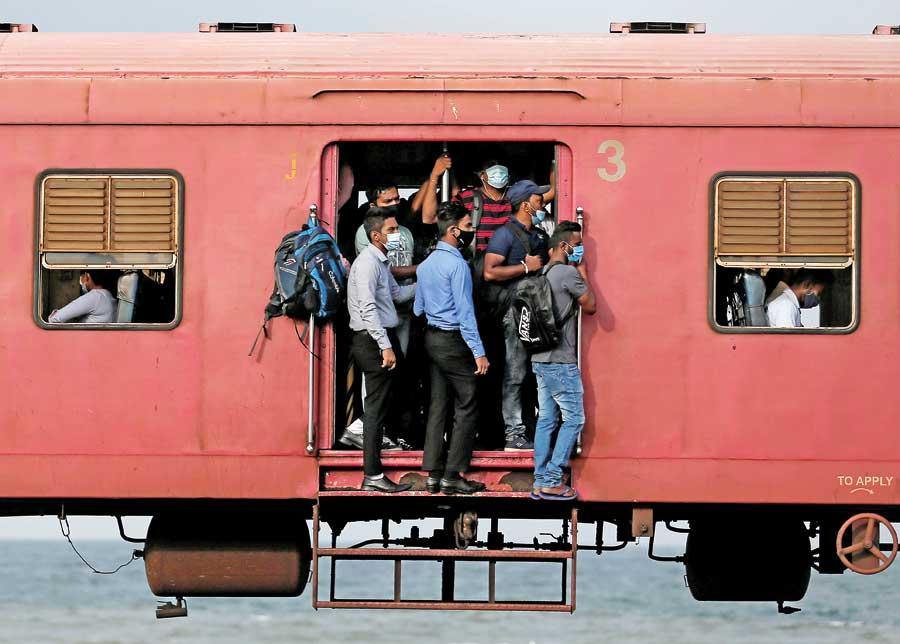03 Feb 2022 - {{hitsCtrl.values.hits}}

"An expert’s take on rejuvenating Sri Lanka’s ailing railway system"
“Sri Lanka Railways isn’t a profit-earning agency but a service provider and we should focus on providing the best of that service. We have to modernise our train stations and utilise our assets for the passengers,” said Dr Prianka Nalin Seneviratne, independent consultant and licensed professional engineer during an online discussion with the Advocata Institute on the importance of reforming Sri Lanka’s Railway, the challenges and issues it currently faces, and how to execute workable solutions to better the railway situation in our country.
of that service. We have to modernise our train stations and utilise our assets for the passengers,” said Dr Prianka Nalin Seneviratne, independent consultant and licensed professional engineer during an online discussion with the Advocata Institute on the importance of reforming Sri Lanka’s Railway, the challenges and issues it currently faces, and how to execute workable solutions to better the railway situation in our country.
"Sri Lanka Railways isn’t a profit-earning agency but a service provider and we should focus on providing the best of that service. We have to modernise our train stations and utilise our assets for the passengers"
"First of all, reliability is an issue because of mechanical breakdowns or safety issues. The performance of the employees is another unreliability including frequent strikes and stoppages. Accessibility to the railways is another issue. There’s also an issue of vandalism and security"
 Q What are the main contributing factors that led to substantial losses in Sri Lanka Railways over time?
Q What are the main contributing factors that led to substantial losses in Sri Lanka Railways over time?
The rising cost of other operating aspects of the railways, the increase in fuel prices, an ageing fleet and infrastructure also increase the operating cost of the railways. There’s also a drop in the market share from 2020 onwards with fewer passengers and less freight movement because of the pandemic. I’m sure the losses will continue largely because of the increasing prices as well as the depleting and deteriorating infrastructure, the locomotives, the wagons and other operating aspects of the railways.
Q Do we have a cost-reflective price mechanism? Is it sustainable?
The price structure does not reflect the operating cost and it doesn’t reflect the operating costs of any railway in the world. Sri Lanka Railways will never be making a profit and I don’t think that the railway should be operating to make a profit. There has to be some form of Government subsidy because the SLR is not only carrying passengers and freight but it’s also doing a public service. It also contributes to reducing emissions and congestion. There are other intangible benefits that the railways bring into the economy. So there are reasons for subsidising the railways and keeping the railways operating. But not at the same level of losses that it’s incurring right now.
Q What’s your take on employee productivity at Sri Lanka Railways?
What’s reported is that there are a lot of vacancies that have not been filled. As a result, people are overworked. The railway employees in general are fairly well paid and get other benefits from the railways subsidised or free travel for the railway employees and their families. It’s a case of not being able to recover the full cost of operations and that’s one of the reasons the railways are making a loss.
Q How important can a freight service be for railway agencies?
Railway freight should be an integral part of Sri Lanka railways. Their freight operations should be made as efficient as the passenger operations. From a social and environmental point of view, carrying freight on the railway makes sense. Part of the reason why the freight share dropped is that the import of certain commodities like cement, rice and fertilizer went to the private sector and they have been focusing more on transport by road. The railways should try to win back some of that and the government should be encouraging more freight by railways.
Q What are the modernization attempts that Sri Lanka railway can take to improve their freight market share?
They have to do some analysis of the freight that could move by railway. Certain commodities are more suited for transport by rail. Accordingly, you have to modernise the fleet and get wagons that are more suited for carrying certain products such as those that need refrigeration. We also have to look at the facilities available at the terminals. They are depleted and the infrastructure is obsolete. Somebody has to look at the market and see what kind of place they want to attract. At the same time, you have to provide a service so that these projects don’t get stalled because of unreliability and the low frequency of the railways. I believe that the railways should have a commercial outlook. Of course, we are not an agency that’s making a profit but we provide a service. And we should focus on how to provide the best of that service.
Q What’s the state of passenger service in Sri Lanka and its challenges at the moment?
First of all, reliability is an issue because of mechanical breakdowns or safety issues. The performance of the employees is another unreliability including frequent strikes and stoppages. Accessibility to the railways is another issue. There’s also an issue of vandalism and security.
They should also cater to senior citizens and people with disabilities. Simple things can be done without significant investment like improving the facilities of the washrooms that would attract more passengers. Another aspect is the modal integration and having multimodal services. Technology has to be brought in such as online tickets and real-time pricing. Because of peak travel, there are a lot of idle assets. If we can spread the peaks, we can utilise the assets more and there’s an opportunity to generate more revenue.
Q How can tourism be integrated into the Sri Lanka Railway system?
In most countries, there aren’t any special travelling methods for tourists. They all get on the same train and travel like everybody else does. I do not believe that we need a special type of service for the tourists. We only have to change the overall quality of service. We already have first, second and third classes. So tourists can buy a first-class ticket if they want the same way locals can. There shouldn’t be discrimination or charging more from tourists and it’s good if the tourists can mix with the local people. There are many ways of generating revenue for the railways, they don’t necessarily have to increase passengers. Tourists aren’t looking for special services in an observation car but they want a reliable service to go from A to B at a fair price that’s safe and secure.
If you try to recover a larger portion of the travel cost from the first-class passengers and give the third class passengers an equal right, then it won’t be workable. People aren’t going to be willing to pay that high price for first-class travel when they know that they’re being skinned off.
Q What are the avenues that Sri Lanka Railways can take for profitable revenue generation by utilising the assets they already have, particularly land?
We can start with the railway stations and buildings we already have. There are tremendous amounts of space within the terminals that can be converted into space for restaurants, grocery stores or bookshops. The railways themselves have a lot of space that could be used for advertising. We have to look at it in a long-term view. There are a lot of empty lands that are used as storage areas. We have to resettle the people in these lands or pay them compensation to move out. But the railways don’t have any sense of their assets or holdings.
Q What are your ideas on electrification of trains and privatisation of railways?
Electrification is not only a case of saving our diesel or an issue of becoming cleaner. It is also about improving the speed of the railways. In order to recover from the investment in electrification of the railways, you have to run the trains faster. The operating speed is now about 40km per hour and they’re looking to increase it to 80km per hour. But journey speeds are still less than 40km per hour so there is no point in increasing the speed. Running trains at a higher speed means you are also increasing the drag. You might also be increasing the noise and vibration which will have an impact on the people who are living there.
Hence there are environmental and social impacts of this including the capital cost of electrification. I believe that electrification is probably needed but if you do not reorganise or restructure the institution, then that investment isn’t going to be of much value because you’ll be running the services the same way. People were talking about the privatisation of railways.
On one hand, you can privatise and get the private company to come and run them but if they want to make higher profits, they’ll have to start cutting down on the cost. And the first cost-cutting measure will be letting some people go and cutting down various services they provide. To reform the railways and reduce the number of people who are working, we have to make sure that it’s not going to be unfair to the people who are being laid off and those who are staying on. Essentially it’s going to be difficult to address all these issues in one go. We need to carve out some areas that we can focus on and expand as we go along.
Q What are your thoughts on Public-Private partnerships?
Public-Private Partnerships take many forms. Private sector stakeholders can come in and make small investments and it brings in a lot of advantages. By allowing the railway stations to be operated by the private sector, they can make it more attractive, put in more lighting and make it a liveable place for the passengers.
Therefore that kind of Public-Private partnership will probably be more acceptable to the people and even the railways themselves if you structure it right.
There would be less opposition. It seems like the regulators and the Ministry of the Railways don’t have much knowledge or control over how the railway operates. The people in the railways are doing all the leasing, operations and scheduling by themselves. There’s no input from the Ministry and it is partly because the Ministry doesn’t have the expertise to do that or the people to oversee it.
26 Nov 2024 9 minute ago
26 Nov 2024 47 minute ago
26 Nov 2024 1 hours ago
26 Nov 2024 2 hours ago
26 Nov 2024 3 hours ago